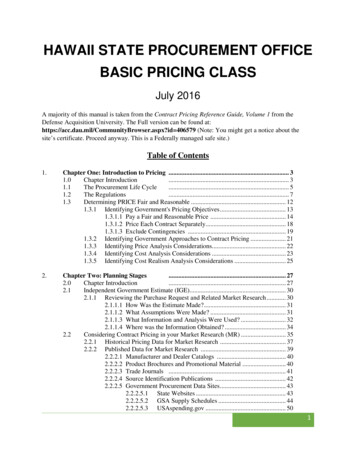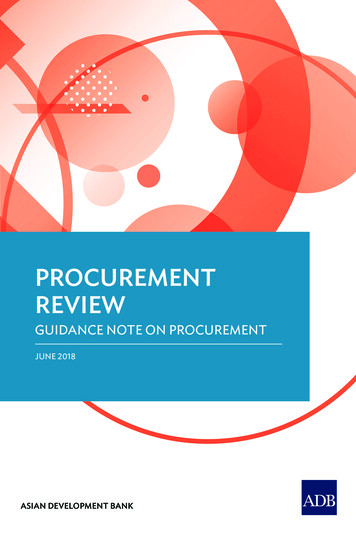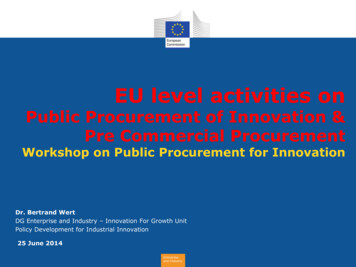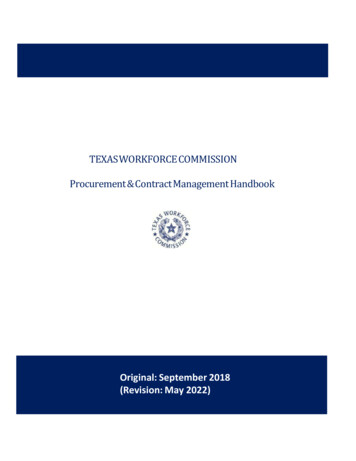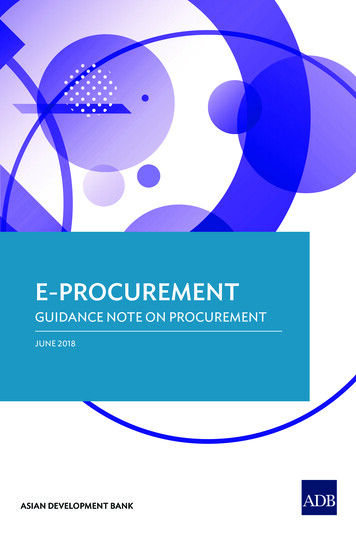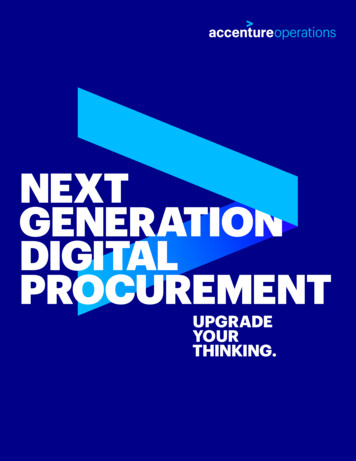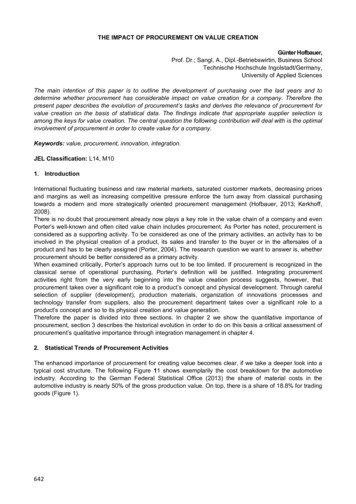
Transcription
THE IMPACT OF PROCUREMENT ON VALUE CREATIONGünter Hofbauer,Prof. Dr.; Sangl, A., Dipl.-Betriebswirtin, Business SchoolTechnische Hochschule Ingolstadt/Germany,University of Applied SciencesThe main intention of this paper is to outline the development of purchasing over the last years and todetermine whether procurement has considerable impact on value creation for a company. Therefore thepresent paper describes the evolution of procurement’s tasks and derives the relevance of procurement forvalue creation on the basis of statistical data. The findings indicate that appropriate supplier selection isamong the keys for value creation. The central question the following contribution will deal with is the optimalinvolvement of procurement in order to create value for a company.Keywords: value, procurement, innovation, integration.JEL Classification: L14, M101. IntroductionInternational fluctuating business and raw material markets, saturated customer markets, decreasing pricesand margins as well as increasing competitive pressure enforce the turn away from classical purchasingtowards a modern and more strategically oriented procurement management (Hofbauer, 2013; Kerkhoff,2008).There is no doubt that procurement already now plays a key role in the value chain of a company and evenPorter’s well-known and often cited value chain includes procurement. As Porter has noted, procurement isconsidered as a supporting activity. To be considered as one of the primary activities, an activity has to beinvolved in the physical creation of a product, its sales and transfer to the buyer or in the aftersales of aproduct and has to be clearly assigned (Porter, 2004). The research question we want to answer is, whetherprocurement should be better considered as a primary activity.When examined critically, Porter’s approach turns out to be too limited. If procurement is recognized in theclassical sense of operational purchasing, Porter’s definition will be justified. Integrating procurementactivities right from the very early beginning into the value creation process suggests, however, thatprocurement takes over a significant role to a product’s concept and physical development. Through carefulselection of supplier (development), production materials, organization of innovations processes andtechnology transfer from suppliers, also the procurement department takes over a significant role to aproduct’s concept and so to its physical creation and value generation.Therefore the paper is divided into three sections. In chapter 2 we show the quantitative importance ofprocurement, section 3 describes the historical evolution in order to do on this basis a critical assessment ofprocurement’s qualitative importance through integration management in chapter 4.2. Statistical Trends of Procurement ActivitiesThe enhanced importance of procurement for creating value becomes clear, if we take a deeper look into atypical cost structure. The following Figure 11 shows exemplarily the cost breakdown for the automotiveindustry. According to the German Federal Statistical Office (2013) the share of material costs in theautomotive industry is nearly 50% of the gross production value. On top, there is a share of 18.8% for tradinggoods (Figure 1).642
Figure 1: cost structure in the automotive industry in the year 2013This means, that the share of sourced volume in the automotive industry even exceeded two- thirds of allcosts. Cost reduction through material savings has therefore a far higher leverage effect on a company’scost and value position than wages, salaries and related expenses for example.2010201120122013Figure 2: evolution of used trading goods in the automotive industryHaving subcontracted a lot of parts of their production to external suppliers, manufacturers increasinglybecome dependent on these suppliers with regard to developing and innovating their products. As643
2010201120122013Figure 2 indicates, this number of interrelationships is considerably high and also increasing. From the year2010 till 2013 the share increased from 14.1% up to 18.8% and is at present considerably larger than grosssalaries, which where only at 12.3% in 2013.But it is not only a matter of volume. Companies need innovations to create competitive advantage andvalue. In order to realize them in a quick and efficient way, they need to cooperate with and even integratethe suppliers.Figure 3: evolution of patents granted (Schiele, 2010)Two main points emerge from the data in Error! Reference source not found. First, innovations are notonly created by the OEMs, but also by suppliers. Second, the number of patents granted increased rapidlywithin only ten years.644
Figure 4: percentage of supplier patents in 1992 and 2002 (Schiele 2010)From the pie chart in Figure 4 it is apparent that the number of supplier innovations not only increased intotal but also the proportion has shifted. In 1992 patents where created nearly at the same amount bysuppliers and OEMs. The figures in 2002 show a different picture. There is a large difference between thenumber of innovations from suppliers and OEMs. Almost two-thirds (65%) of the patents granted came fromsuppliers. These results show a notable influence from supplier’s side to the OEMs and demonstrate the highinnovation power of procurement markets. These data further support the supposition, that procurement ismore than a secondary activity, just buying at the lowest price. Therefore the main challenge for procurementmanagers is to identify and utilize innovative suppliers as well. Unfortunately in practice more attention hasbeen placed on the cost reduction aspects of supply chain management so far (Tracey/Neuhaus, 2013, p.98).3. The Way from Purchasing towards ProcurementIn former times the operational buying execution was recognized as an assisting activity for other managerialfunctions within the value chain of a company. Since the end of the 1980s, the meaning of procurement hasbecome subject to constant change (Lingohr/Kruschel, 2011, p. 87).This change is particularly due to the ongoing and increasing concentration on core competencies of theOEMs and as a consequence thereof the reduction of steps in the production process as well as on differentresearch and development levels. Instead of producing all the necessary parts and components on theirown, they are more and more sourced from suppliers, which can produce those parts and modules oftenmore economically. These suppliers concentrate on their core competencies and combine volume on theirrelevant value-added step.Figure 55 (Becker, 2003, p. 77) displays the most important steps of the development of procurement duringthe last 50 years.Figure 5: Stages of development of procurement emphases645
As detailed in Figure 55, we can see the subject matters of procurement along the time line. At the verybeginning the purchasing department had to buy parts at the lowest price. The main task was costoptimization. The next step was the introduction of a structured process within the company in order toexecute the buying process in the most efficient way. After this process optimization of procurement thesuppliers were brought into focus. The scope was to combine the value chains of the suppliers with thecompany’s own supply chain. The goal was to improve the performance of suppliers and to avoiddiscontinuities in the supply chains. The latest step was the integration management. Here we distinguishbetween vertical and horizontal integration.It is therefore not surprising that the process of purchasing is currently referred to as procurement, sourcing,management of external resources and supply (chain) management.According to the results of a recently done preliminary study the operational and administra- tive fields ofpurchasing will completely disappear (Pellengahr/Schulte/Richard/Berg, 2016).4. The next step: Integration ManagementLeading companies require a proactive and agile procurement department which is focused on value andinnovation in addition to cost optimization and compliance activities (KPMG, 2010; Figure 6).Figure 6: responsibilities of procurementIn interpreting these findings, we need to consider that the role of procurement will exceed the pure suppliermanagement and proceed further on towards the management of a network. As a consequence of anincreasing level of integration in creating value, tier structures (performance bundling) and outsourcing(solution bundling) will gain in importance and the selection of suppliers to be integrated will become a keysuccess factor (Hofbauer/Sangl 2011, p. 479).Based on a well-structured procurement management process, suppliers are more and more involved toimprove their performance and quality of parts to be delivered. After having improved the capabilities of thesuppliers, some of them are able and willing to take more responsibility. They are called Tier-1 suppliers andhave a higher level of integration and value creation. Here we talk about performance bundling. In this caseall steps of the processing depth and of total added value of a specific system or module are managed bythe Tier-1 supplier. In the case of solution bundling, all the different modules and/or systems are delivered bydifferent Tier-1 suppliers. The OEM has outsourced all upstream activities (research and development,logistics, manufacturing, testing), but the downstream activities (sales and marketing) are done under theOEM’s own brand.There is already a trend of OEMs and their subcontractors towards performance and solution bundling,especially in the automotive industry. OEMs are concentrating on their core competencies. Other activitiesare transferred to suppliers and their core competencies to the extent of performance and solution bundling.Large and complex supply chains arise as a result, which influence the company’s success on a large scale.These activities shall be initiated, continued and controlled by procurement. Accordingly, the importance ofan efficient and strategically aligned supplier management as a prerequisite rises.New challenges for the procurement management are coming along with new business models. Thesebusiness models combine products and services in the horizontal dimension as service providers. A carmanufacturer for example does not only sell just cars anymore, but provides mobility services. These mobilityservices shall support the core business in selling and providing cars. To gain a competitive advantage,these mobility services include information about navigation, guidance, traffic warning, parking, hotels,restaurants, points of interest and even booking and payment services.For this reason the role and meaning of the procurement management is changing again. A completenew dimension is provided in the space between a higher “level of supplier/partner integration” on the x-axis646
and the “level of integration in value creation” on the y-axis. Suppliers become more and more partners inproviding a specific bundle of benefit.Error! Reference source not found. illustrates the aspired space of new business opportunities at ahigher level of integration. There will be higher potential of business and a higher extent of differentiationtowards the customers, but also requires higher investment.Figure 7: Future challenge horizontal integration management (own graph)Revolutionary innovations by singular inventors like Edison’s light bulb are quite rare nowadays. More thanthree-fourths of all innovations result from combining a variety of disciplines (Stadler, 2016). All thesechanges provide new possibilities for creating value, combining different contributions to a complete benefitbundle on the highest value-added level. All the different contributions of that bundle have to be identified,specified, analyzed and procured from the providers of the sourcing market. The principal methods ofprocurement have to be applied therefore to objects and services, just on a higher level of integration.5. CONCLUSIONProcurement has the highest impact on cost position of a product as we demonstrated with statistical data insection 2. In conclusion a company’s value is strongly correlated with successful procurement activities.Furthermore we observed changes in business operations on a large scale. More and more companiesdefine their purchasing function no longer as the operational buying execution only at the best price. In thesense of procurement the whole supply chain and value creation process have to be managed in an effectiveand efficient way. In doing so, there is a strong impact of the suppliers’ activities to the physical creation ofparts, modules systems or products delivered to the original equipment manufacturer. Especially withinnovation, design and manufacturing suppliers can influence the physical configuration and value creationof sourcing parts. These activities start at a very early stage in the product or service management with thedefinition of specifications based on market needs and ends with the delivery and use of the product orservice by the end consumer. Procurement has changed into a value creator by integrating internal activitiesand combining them uninterruptedly with the value creating activities of the suppliers. Nowadays the valueposition is more driven by innovations coming from sourcing markets than by price reductions. New businessmodels require more sophisticated procurement processes and integration activities. Therefore we postulateto consider procurement not any more as a secondary activity, but as a primary activity within the value chainof a company.References1. Becker, W.: The Network of Automotive Excellence as a Potential Response to Change inDevelopment/Production and Brand Policy, in: P. Sachsenmeier & M. Schottenloher: Challengesbetween competition and collaboration, Berlin, Springer Verlag, 2003, p. 63-78, 326 pages.647
2. Hofbauer, G.: Technisches Beschaffungsmanagement, Berlin, uni-edition, 2013, 268 pages.3. Hofbauer, G., Mashhour, T., Fischer, M.: Lieferantenmanagement, Die wertorientierte Gestaltung derLieferbeziehung, 3rd ed., Berlin, De Gruyter Oldenbourg, 2016, 139 pages.4. Hofbauer, G., Sangl, A.: Professionelles Produktmanagement, Der prozessorientierte Ansatz,Rahmenbedingungen und Strategien, 2nd ed., Erlangen, publicis publishing, 2011, 578 pages.5. Kerkhoff, G.: Milliardengrab Einkauf: Einkauf - die Top-Verantwortung des Unternehmers nicht nur inschwierigen Zeiten, 2nd ed., Weinheim, WILEY-VCH, 2011, 265 pages.6. KPMG Advisory US: Procurement as a value lever, 2010, 12 pages.7. Lingohr, T., Kruschel, M.: Best Practices im Value Management: Wie Sie durch Einkauf und Technikeinen nachhaltigen Wertbeitrag leisten können, Wiesbaden, Gabler Springer Verlag, 2011, 308 pages.8. Pellengahr, K., Schulte A., Richard, J., Berg, M.: Vorstudie Einkauf 4.0 – Digitalisierung des Einkaufs,2016, Dortmund/Frankfurt, Fraunhofer-Institut für Materialfluss und Logistik IML/BME BundesverbandMaterialwirtschaft Einkauf und Logistik, Frankfurt, 2016, 33 pages.9. Porter, M. E.: Competitive advantage: Creating and sustaining superior performance, New York, NYFree Press, 2004, 557 pages.10. Schiele, H.: Innovationsquelle Lieferant, Vortragsunterlagen, Ingolstadt, 2012, 24 pages.11. Stadler, R.: Business Innovation in der Automobilindustrie in: C.P. Hoffmann, S. Lennerts, C. Schmitz,W. Stölzle, F. Uebernickel: Business Innovation: Das St. Galler Modell, Wiesbaden, Springer Verlag,2016, 542 pages.12. Tracey, M., Neuhaus, R:. Purchasing's role in global new product-process development projects, in:Journal of Purchasing and Supply Management, Amsterdam 2013, Issue 2, Volume 19, p. 98–105, 118pages.648
procurement, section 3 describes the historical evolution in order to do on this basis a critical assessment of procurement's qualitative importance through integration management in chapter 4. 2. Statistical Trends of Procurement Activities The enhanced importance of procurement for creating value becomes clear, if we take a deeper look into a



